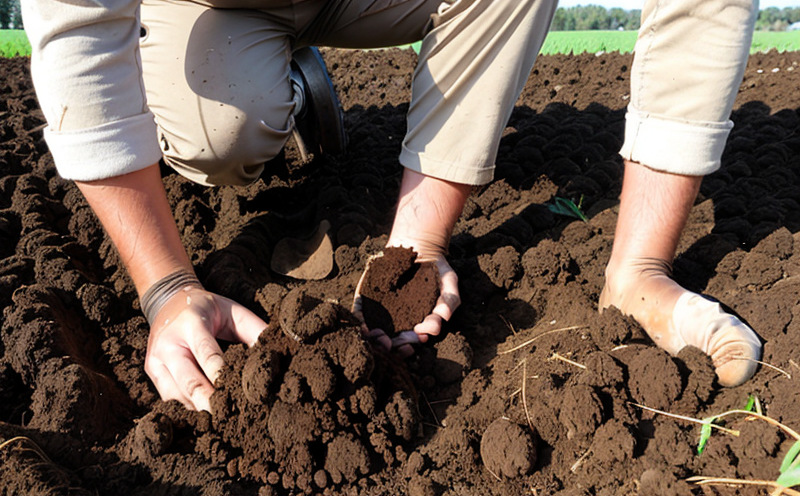Soil Field Capacity Testing
The soil field capacity test is a crucial diagnostic tool in agriculture and forestry testing. It assesses the amount of water that can be held by the soil at field capacity, which is essential for understanding the moisture retention capabilities of different soil types.
This information is vital for optimizing irrigation practices, enhancing crop yields, and ensuring sustainable land management. The test helps determine how much water a given soil type will hold when it has had an opportunity to drain but still retains some moisture at field capacity. This value is critical in agricultural planning, as it informs the amount of water that should be applied during irrigation without causing overwatering or underwatering.
In forestry testing, understanding field capacity helps with forest management practices such as fertilization and pest control. It aids in assessing soil health and identifying potential issues before they exacerbate into larger problems. Soil field capacity is also a key factor in determining the optimal planting density for crops and trees, ensuring that each plant has enough water to thrive.
The test procedure involves collecting soil samples from various depths within the root zone of plants or in areas where specific soil characteristics need to be evaluated. These samples are then dried until they reach their air-dry state and weighed. After drying, the samples are reweighed while still saturated with water. The difference between these two weights provides an accurate measurement of field capacity.
The significance of this test extends beyond just irrigation planning; it plays a pivotal role in environmental conservation efforts by minimizing water wastage. By accurately determining how much water each soil type can hold, farmers and foresters can implement more efficient watering schedules, reducing both water usage and associated costs.
Understanding field capacity also aids in predicting drought conditions and managing water resources effectively during dry periods. It helps in planning for crop rotation and selecting appropriate crops based on the specific characteristics of different soils. This knowledge is particularly important in regions prone to climate change-induced variability in rainfall patterns, where precise soil moisture management becomes even more critical.
For quality managers and compliance officers responsible for ensuring sustainable practices within their organizations, knowing field capacity ensures that all operations adhere strictly to environmental regulations related to water usage and waste management. The accuracy of the test results directly impacts these individuals' ability to meet regulatory requirements while maintaining high standards of sustainability.
Applied Standards
The soil field capacity test is standardized according to several international protocols that ensure consistency and reliability in testing methods across different regions and industries. These include:
- ISO 8039:2014 - Soil quality - Determination of the field capacity of soil
- ASTM D2536-16 - Standard test method for determining moisture retention characteristics of soils and soil mixtures using oven drying
- EN 1978:2002 - Soil quality - Determination of the field capacity of soil by gravimetric method
- IEC 62374-2010 - Agricultural machinery and implements - Particular requirements for soils testing equipment
These standards provide guidelines on sample preparation, equipment calibration, and data interpretation to ensure that the results from various laboratories are comparable.
Scope and Methodology
| Aspect | Description |
|---|---|
| Sample Collection | Samples should be collected using a soil probe or auger, ensuring that they represent the entire profile depth relevant to root growth. Samples must be taken from multiple locations within the field to account for spatial variability. |
| Drying Procedure | The collected samples are dried in an oven at 105°C until constant weight is achieved, indicating complete drying. This process removes all free water and leaves behind only bound water content. |
| Saturation Procedure | After drying, the samples must be allowed to absorb water back up to field capacity under controlled conditions, typically using a vacuum chamber or capillary action. |
| Weighing and Calculation | The final step involves weighing both the dry sample and the fully saturated sample. The difference between these weights represents the field capacity of the soil in terms of mass per unit volume. |
The accuracy of this test relies heavily on precise measurements throughout each stage, from initial sampling to final calculation. Deviations at any point can lead to inaccurate results, which may have significant implications for subsequent decisions regarding irrigation schedules or soil management strategies.
Why Choose This Test
The soil field capacity test offers numerous benefits that make it an indispensable tool in agricultural and forestry testing:
- Precise Water Management: Accurate knowledge of field capacity enables precise control over irrigation levels, preventing both water wastage and under-watering.
- Sustainable Practices: By optimizing the use of resources like water, this test supports sustainable agricultural practices that benefit both the environment and economic viability.
- Predictive Capabilities: Understanding field capacity helps predict drought conditions and manage water resources more effectively during periods of low rainfall or high evaporation rates.
- Ethical Responsibility: Ensuring efficient use of natural resources aligns with broader ethical considerations, promoting responsible stewardship of land and water.
- Scientific Insights: The test provides valuable scientific data that can inform ongoing research into soil health and crop productivity.
- Regulatory Compliance: Adhering to best practices ensures compliance with environmental regulations related to resource use, contributing to a healthier planet.
- Better Crop Yields: Proper management of soil moisture directly impacts plant health and growth rates, leading to higher yields and better quality produce.
In summary, the soil field capacity test is not just a technical procedure; it represents a holistic approach to sustainable agriculture and forestry that benefits multiple stakeholders—from farmers and foresters to consumers and environmentalists alike.





